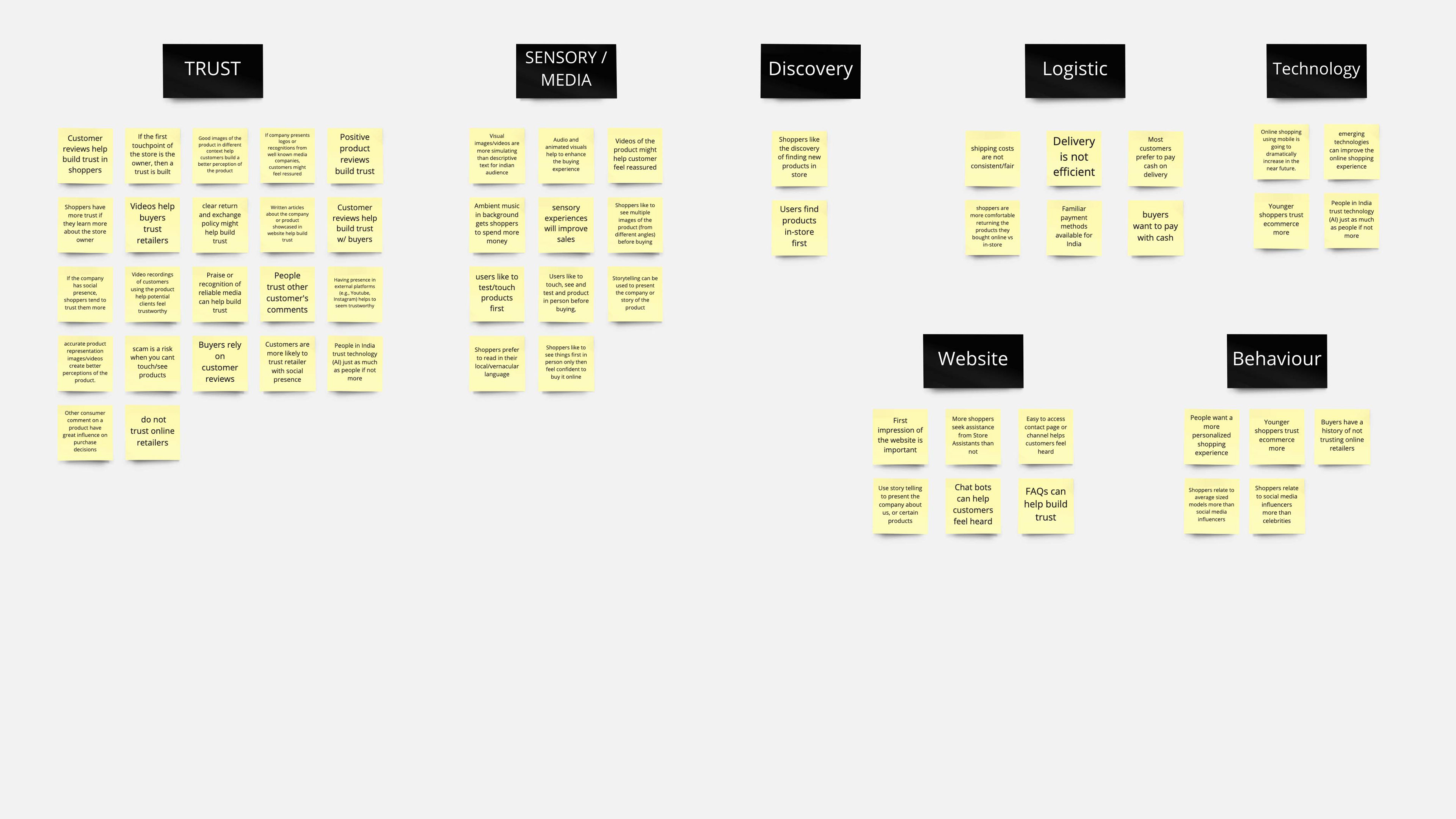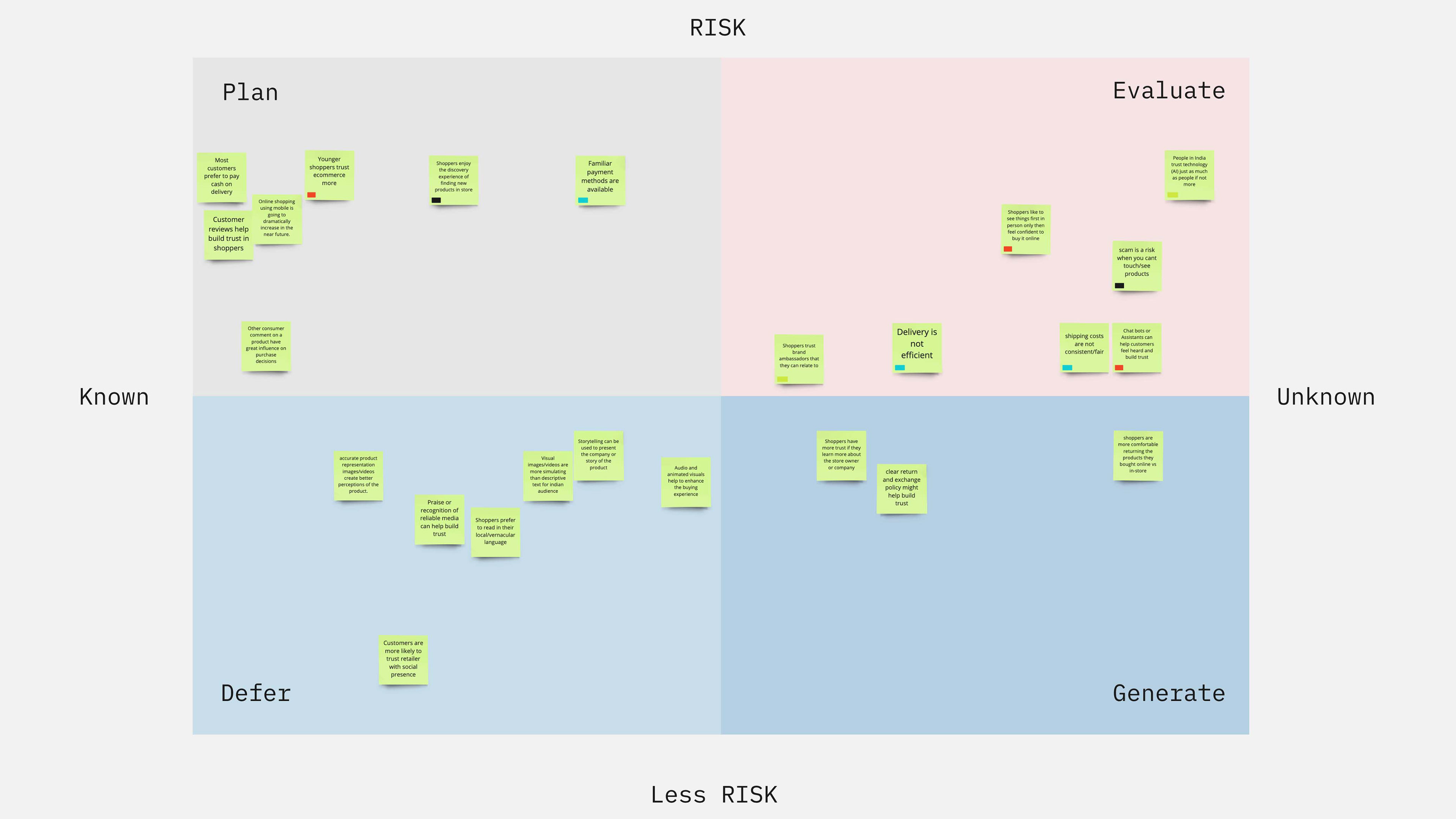Ai Designer Quiz for an Enhanced Online Shopping Experience.
AI Designer is an AI-assisted quiz designed for furniture stores that wish to provide users with a personalized shopping experience. The product is a Shopify App (prototype) thought out to enhance the online shopping experience by providing recommendations based on the user's space, needs and aesthetic preferences.
The Project
The project took place as a 12-week Capstone Project for the Master in Digital Experience and Innovation at the University of Waterloo. Our team collaborated with Shopify to uncover potential solutions to the challenge "How might we bring brick and mortar sensory experiences online so that consumers around the world can get enriched shopping experiences like they may get in-store?".
The Team
Alyssa Pasek - Project Manager
Ethel Zlotnik - Team Lead
Husain Zaidi - Research Lead
Lucas Andrada - Design Lead
My Role
Design Lead
• Creative Facilitation
• Prototyping
• User Testing
• Visual Design
The project took place during the Covid-19 lockdown which meant the team had to collaborate remotely.
Miro was the go-to tool for whiteboard brainstorming and collaboration, Figma the preference for prototyping, and Notion for project management.
Background
Background information provided by project partner:
"Despite the number of online shoppers continuing to rise, many consumers still prefer to shop in-store. This is especially true for product categories like groceries, luxury and apparel where current e-commerce capabilities do not replicate the sensory experience consumers want during their purchase decision process. With COVID-19, retailers around the globe have been forced to close their retail stores, adopt curb-side pickup, and limit operating hours. Consumers are also moving shopping online, a habit that many predict will last for the long haul. As a result, there is a pressing need to find ways for brick and mortar businesses to adapt to in-store shopping expectations around the world and bring their unique in-store advantages online. By closing the sensory gap, businesses will help their consumers make confident purchase decisions online like they otherwise would in-store."
Understanding the Problem
Narrowing down scope:
The team's goals for the project were not only to gain a better understanding of the problem area, but to also discover a potential solution which would be delivered as a working prototype at the end of the term. Transforming the online shopping experience is no 12-week task, which meant the first step towards achieving those goals was to narrow down the scope.
Selecting the Market:
We focused on three of the provided target markets: Brazil, China & India.
Market research was then conducted encompassing 3 main points of interest:
• How do consumers make purchase decisions in each of the markets?
• What is the consumers' behavior when shopping in-person vs. online (and what are the implications of sensory experiences)?
• How do each of these markets interact with digital technology? (One of the team's motivations was the opportunity to apply emerging technologies to our solution, such as AR, VR, AI and/or others).
After collecting data from secondary research, we organized our finding in potential advantages and disadvantages related to each of the markets.
After collecting data from secondary research, we organized our finding in potential advantages and disadvantages related to each of the markets.
India was selected as the primary market of interest due to two main findings:
• The Indian market is positioned as a leading mobile-first consumer economy. Meaning that most users access the internet through a mobile device. Additionally, in India, most purchases involve the use of a mobile to either purchase and/or discover/research before purchasing.
• A considerable number of users follow a non-linear shopping journey. Meaning that the decision-making process usually involves a mixed method of discovery and research online followed by the purchase in-person, or vice versa.1
Picking the industry
Although focusing on a specific industry was not required on the brief, the team decided to narrow down on the furniture and home decor industries. The decision was based on individual interest between team members, the market research findings previously mentioned, and the need to narrow down to scope in order to achieve the team's goal. Additionally, the priorly mentioned mixed method of purchase seemed to accentuate more in industries such as luxury products, apparel, and furniture.
Problem Workshop
Uncovering Assumptions
After analyzing the data collected through secondary research, I lead an Assumption Slam workshop with the purpose of:
• Finding out if there was evidence to back up our beliefs.
• Deciding if it was risky to move on unvalidated beliefs.*
During the exercise, we listed out all our assumptions about the problem, market, and industry. We then organized them into general categories before mapping them on a known vs. unknown axis (based on factual knowledge) and a risk vs. less risk axis (based on how much they would impact the outcome). The Assumption Slam set the basis for our primary research by providing the team with an understanding of the areas that needed further research and helping plan interview questions.


Asking Users:
We interviewed individuals from India that matched our target audience. All users had purchased furniture within the last 12 months and they all had experience shopping both in-person and online (whether it was furniture or not). The questions asked during the interviews ranged from general purchasing behavior, to previous shopping experiences, to specific questions about their preferences when shopping furniture.
The large amount of data collected on the fieldwork was organized during an affinity diagramming session. Affinity diagraming was particularly effective at this stage because not only did it help code data into themes (such as "sensory experience", "purchase journey", "information architecture") but it also sparked the sharing and communicating of findings between team members, deepening the understanding of the problem researched.
The design process
MVP (minimum viable product)
A Shopify App for furniture stores that helps customers narrow down results based on their needs, space, and aesthetic preferences.
We prototyped, we tested, we improved, we tried again.
We opted for a Rapid Iterative Testing and Evaluation (RITE) method. With this method we were able to prototype, test (with 2-4 users), evaluate feedback, and make changes regularly and quickly (in our case once a week).
Rapid iterations, are highly effective to quickly identify usability issues while giving the opportunity to react and test new solutions immediately. The fact that each usability session only requires 2-6 participants is another one of the benefits of RITE which can also prove to be time and cost-effective.
Rapid iterations, are highly effective to quickly identify usability issues while giving the opportunity to react and test new solutions immediately. The fact that each usability session only requires 2-6 participants is another one of the benefits of RITE which can also prove to be time and cost-effective.
Is Less More?
Between iterations 2 and 3, we noticed some users were taking longer than expected to complete particular steps related to multiple selection options. In the following iterations, we focused on simplifying our solution, reducing the number of clicks (clicks to completion), and reducing completion time. By reducing the number of clicks to less than half, we achieved a lower drop-off rate (users leaving before completing the quiz) and it encouraged users to repeat the quiz more than once.
The Result
Our prototype was a personalized quiz for furniture stores which would be accessible through Shopify App Store. The product was designed to provide personalized recommendations based on the user's personal preferences and their space (room). When completing the quiz, users are asked to select their preferences on color palette, design style, as well as specifics about their place (room size, room type, etc.).
The quiz can be completed in 2 ways.
The quiz can be completed in 2 ways.
• The first one, by taking or uploading a photo(s) of the room to be analyzed by the AI software, followed by a short set of questions.
• The second one, by completing a personalized quiz that curates design preferences.
After completing the quiz, personalized suggestions based on the user's input are shown on the results page. The items recommended were not only selected based on functionality but also aesthetics.
Although our solution does not include augmented reality (AR) capabilities, it can work simultaneously with already existing Shopify apps that allow for visualizing furniture with AR.
Shopify's Design System Polaris
Prototypes were designed using Shopify’s design system Polaris. Polaris gave us a framework to design a solution cohesive with Shopify's platform, ensuring that not only merchants but everyone interacting with our solution would have a memorable product experience.
Next Steps
About the Product
If the team were to continue working on the project we would:
• Continue iterating and improving prototype based on user testing feedback.
• Research desktop-first markets and implement desktop version of the product.
• Adapt solution to other industries (e.g. fashion, makeup, etc).
• Consider where the product is accessible from in the e-store.
• Upgrade the number of options that users can choose from.
• Upgrade the number of options that users can choose from.
• Research how to further improve sensory experiences while shopping online.
Key Learnings
• "Simplicity is the ultimate sophistication." Finding the perfect balance between creating value and ensuring that users complete the process was key to the success of the project.
• Reducing the number of choices lowers user’s anxiety when making a decision (choice overload).
• Constant feedback reduces drop-off rate.
• Should we talk to users earlier in the process? The first weeks of the project were solely committed to narrowing down the scope, secondary research gave us a solid base and helped answer many of the questions we had. But could talking to people earlier help define the problem area better?
• Should we talk to users earlier in the process? The first weeks of the project were solely committed to narrowing down the scope, secondary research gave us a solid base and helped answer many of the questions we had. But could talking to people earlier help define the problem area better?
• Although encouraged, participants forget to speak aloud during user testing and that's fine too. User testing participants often forgot to speak aloud, yet we took that opportunity to closely observe how they interacted with our prototype. When asked to repeat a task and reminded the think-aloud, they were usually better at communicating the second time around.

